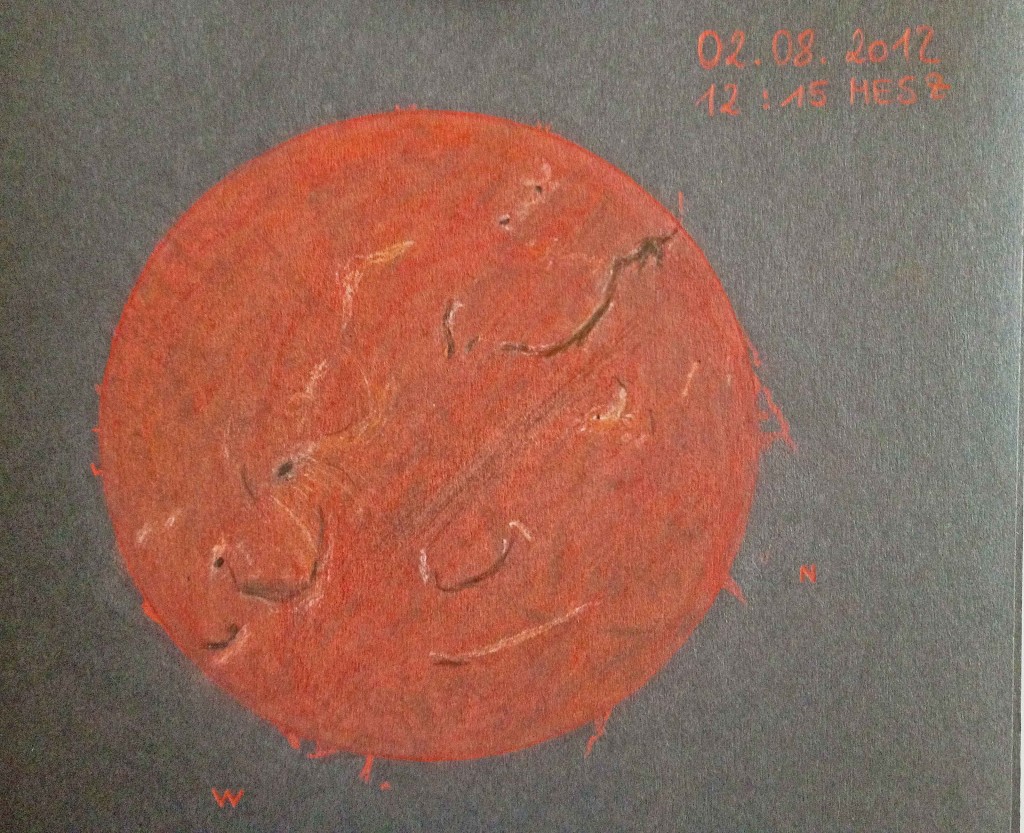
Object Name: H-alpha Sun
Object Typ: Solar System
Location: Stegersbach Austria Europe
Date: Aug. 02. 2012
Media: black paper, red and white drawing chalk,
Telescope: Coronado P.S.T 40, 12,5 mm Okular
Thank you
Markus Vertesich

Hello
this is may first sketch of the sun, it was made on July 25th at 12:45 LT
hope you like it
best regards
—-
Licda. Marcy Malavassi Z.
www.altaircostarica.org

Dear Asod,
Please find attached my sketch about the Sun and the sunspots. This sketch has been made in Polaris observatory, Budapest, with the big 200/2470 refractor. This telescope has an awesome optic it shows the sunspots unbelievably detailed and beautiful. I used a 25 mm eyepiece.
That day it was 38 degrees in Celsius in Hungary, but on the other hand the seeing was great.
Date: 7th July 2012
Time: UT 12:30
Place: Budapest, Hungary
Equipment used: 200/2470, 89x
I used graphite pencils on white paper.
Regards,
Judit
dr. Hannák Judit
Web: http://egmesek.blogspot.com

Object Name: Sun-Sunspots 1512-1513- 1515-1517
Location: Tehran-Iran
Date: July 3, 2012
Time: 14:00 Local Time (+3:30 GMT)
Media: Soft Pastels on Black Fabriano paper
Optic: 80 ED APO Refractor Telescope
Focal Length: 600 mm
Eyepiece: 9mm UWA- 1.25′′- 58º
Photo Details:
Camera: Canon EOS 60D
Shutter Speed: 1/6400 sec
ISO:200
Clear Skies
Mona Sorayaei
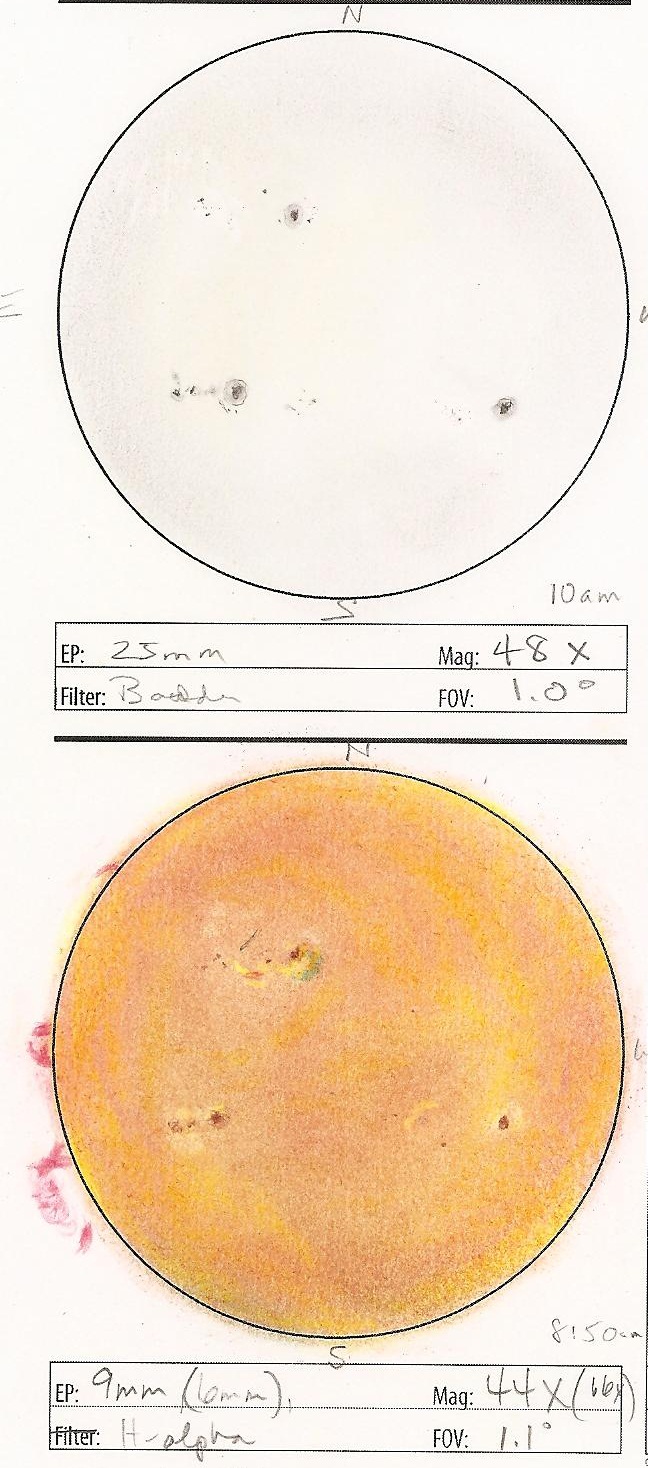
An exciting day under the Sun. Observing with both a Coronado PST h-alpha & white light 8” Dob fitted with a 3.5” solar filter. Sketches were made at the eyepiece(s).
Seeing was good to excellent. After sketching details of the 4 sunspot groups I could readily see with the PST, I noticed one of the plages (bright spots) on the 1513 sunspot brightening intensely. As it brightened the bottom portion (to the South) of the plage developed a greenish/blue hued widening irregularity. There was also a linear band that extended from the widening directly to the center of sunspot 1513. Above the sunspot there appeared a filament which I tried to capture as well in my sketch. Within 5 minutes the dark patch was gone. From some research and asking more experienced friends, I believe I witnessed a solar flare, probably a minor one but still very exciting. I have been observing with the PST for over a month now, but this was a first for me. The plages around all the major sunspots continued to brighten & fade during the observation period, but none to the intensity of 1513. The PST was loaned to me by a friend after my excitement over white light observing. It’s a wonderful instrument showing many features of the Sun not evident in white light solar filters.
Solar prominences on the limb were also detailed today with the larger one appearing as somewhat of a vortex shape, while another more north prominence appeared as a broken loop. I had observed yesterday & did not see this broken loop then.
I moved to white light observing & could see much greater detail in all the sunspots, including many that did not show up well with the PST.
White light filters are primarily for observing details of the photosphere (like sunspots, facule & granulation), where h-alpha narrow bandwidth shows detail in the chromosphere. The chromosphere or “sphere of color” is the second of the three main layers in the Suns atmosphere and is roughly 2,000 kilometers deep. It sits just above the photosphere, and below the corona.
I am in love with the ever changing face of the sun. I am sometimes tired at night by the time the sky clears but the morning is always mine!
Coronado PST 40mm
9mm Plossl 44X
8” Dob w/ masked 3.5” Astro Baader Solar filter (homemade)
25mm Plossl 48X
4,000 ft elevation
Maui, Hawaii
Aloha!
(Cyn) Thia Krach
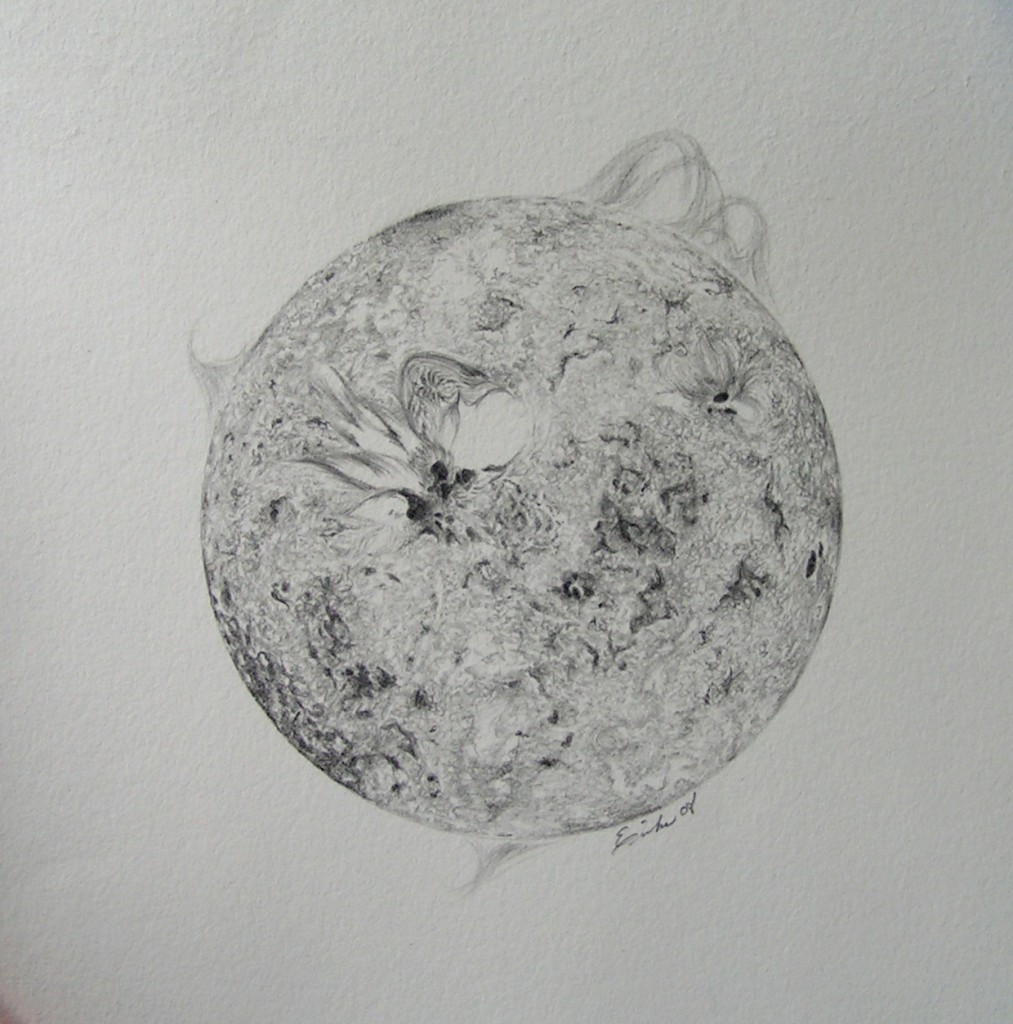
What: The Sun
Where: In my studio, using different multicolor photos of solar flares
Date: 5/2008
Media: graphite on archival print parchment
This is my first submission.
Thank you!
Erika McGinnis
www.erikamcginnisart.com
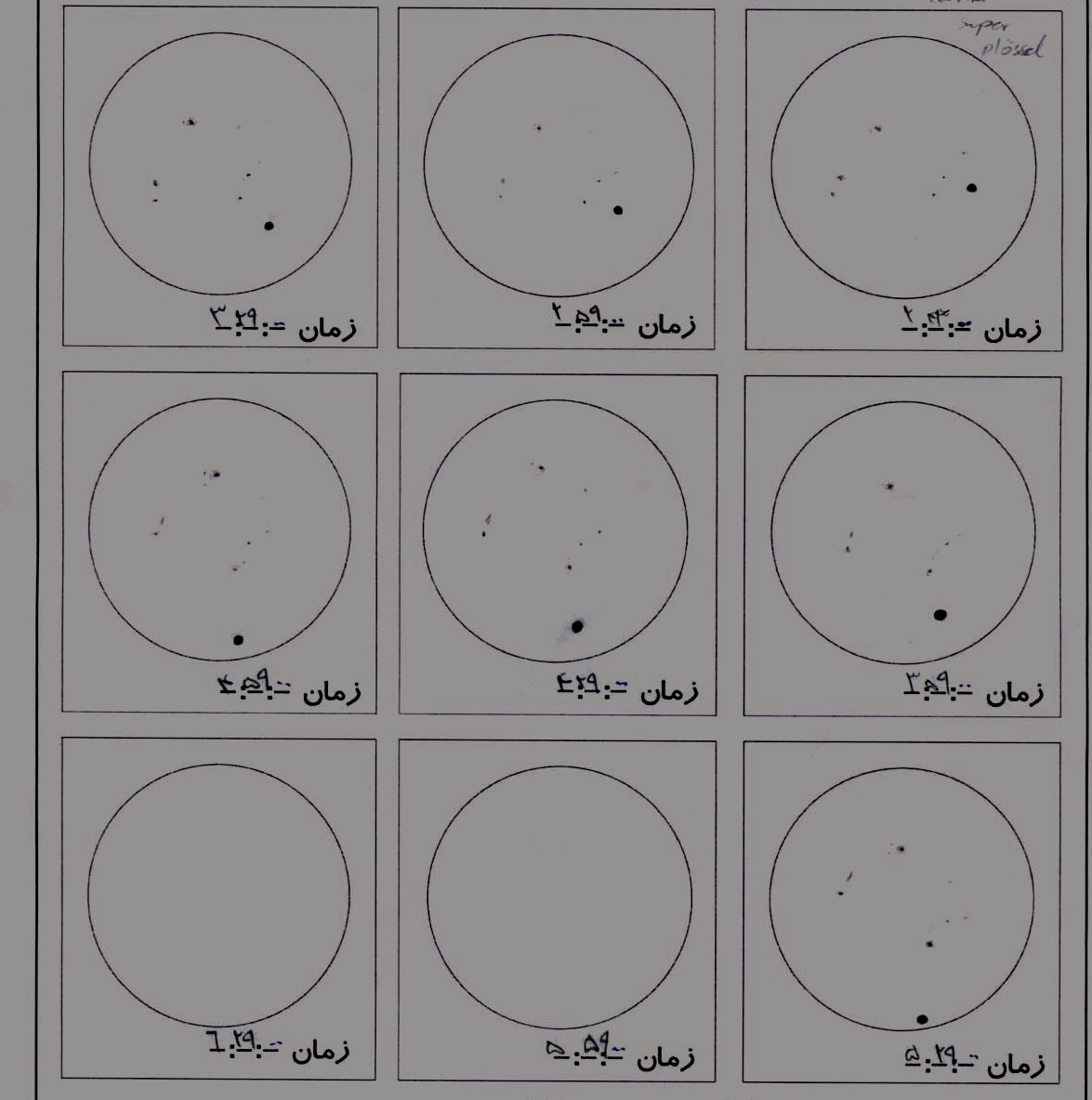
This transit was our last chance to observe, you know. It was really interesting that I had literature exam!
OK, there are some words in the sketch in Persian, but I’ll translate them here.
It’s starting from that part which has
Time: 2:44
Time: 2:59
Time: 3:29
Time: 3:59
Time: 4:29
Time: 4:59
Time: 5:29
Time: –:–
Time: –:–
(The times are not local.)
Object Name: Sun & Venus
Object Type: Star & Planet
Location: Tehran_Iran
Date: 06/6/2012
Media: White Paper + Black Pencil
Equipment: 130 mm Newt & Maylar Filter & 25 mm super plossl
Weather: Sunny
With Regards
Negar Najafi
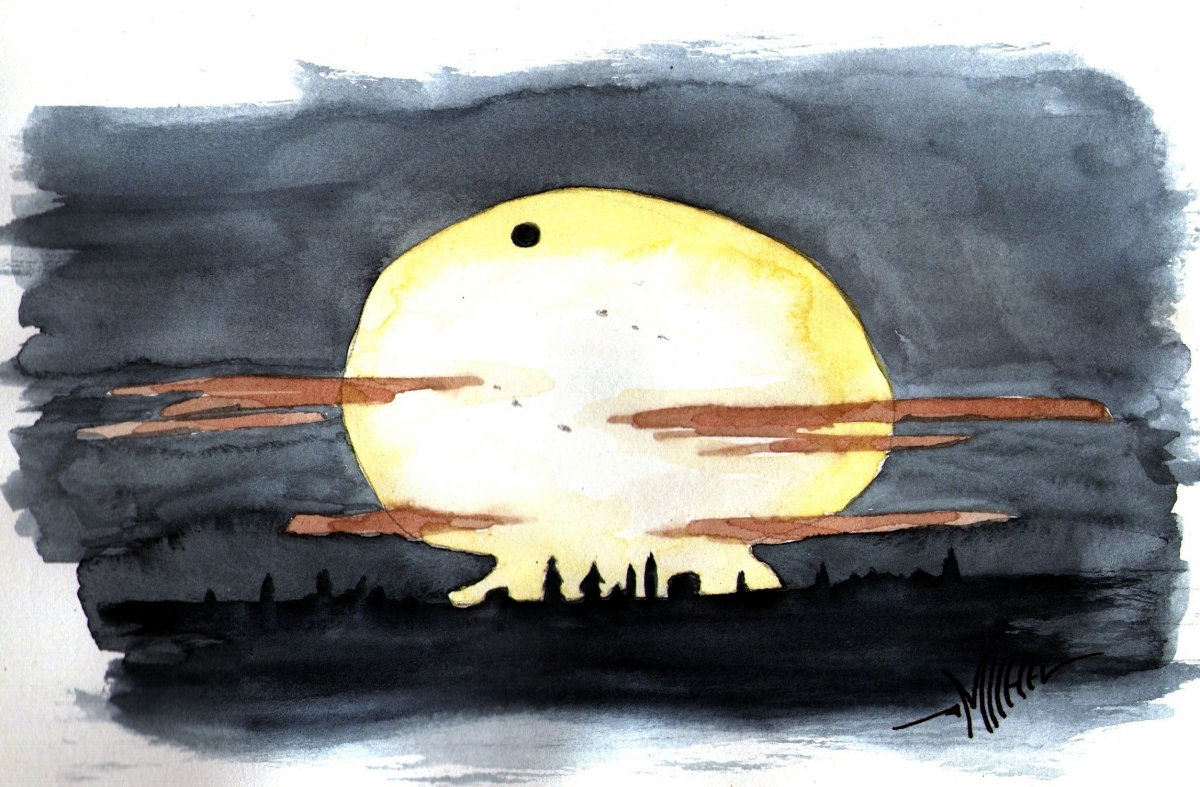
Venus as a star, once more,…
Object Name (Venus transit…)
Location (Néoules – Provence – France)
Date (06-06-2012 & 13-06-2012)
Media (red wine, graphite pencil, watercolour)
Refractor 1000/102
I made this sketch directly while the sun was rising, just with pencil on white paper.
I had to sketch very quickly.
Today, at home I used yellow watercolour and black for the dark part of the sky
For the clouds I used red wine pigment, from here we are in France.
I was on a hill, the time for this sketch was 3:50, 2 or 3 minutes before the theoretical sunrise time, so my telescope was downwardly inclined. Strange and fantastic souvenir.
Clear sky to you all
Michel Deconinck
Site Web: http://astro.aquarellia.com
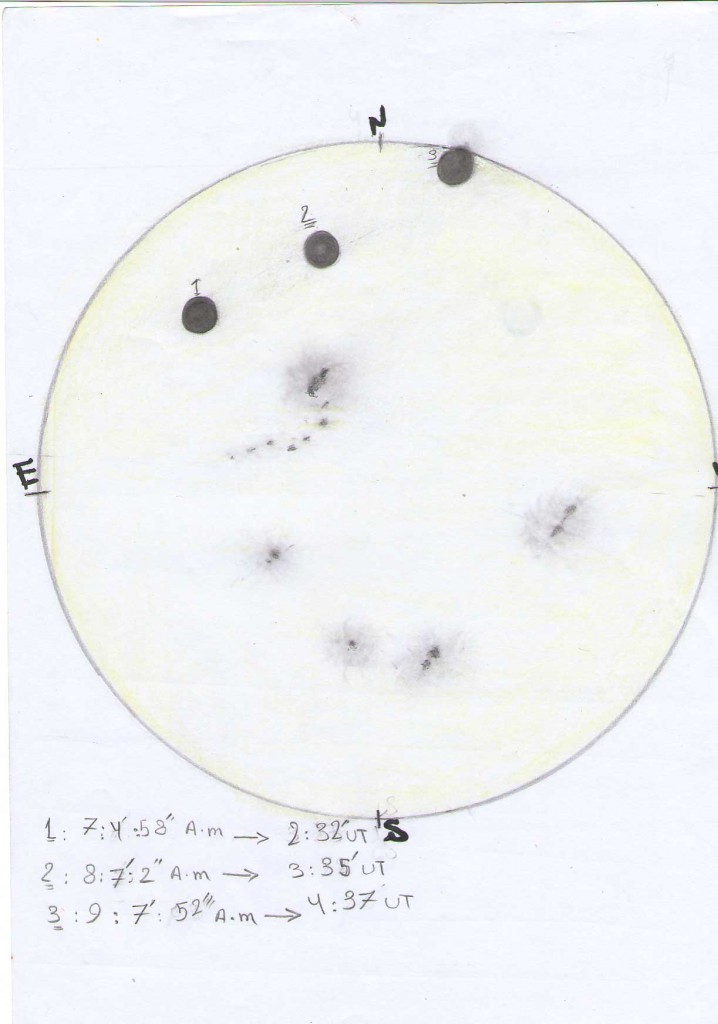
This sketch is transit of Venus in Iran. We have good horizon & the weather its so good & sunny the sky was clean.
Object: Venus transit & sunspot
Location: Milad tower_Iran-tehran 35° 44′ 40″ N, 51° 22′ 30″ E
Date: June 6, 2012
Telescope: 6 inch / Newtonian
Media: graphite pencil & eraser / colored pencil / with paper
Melika bidabadi